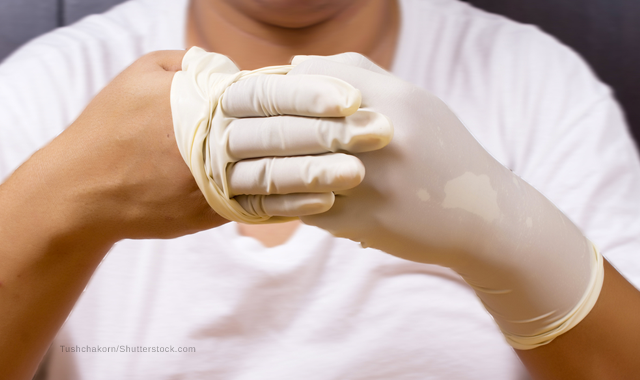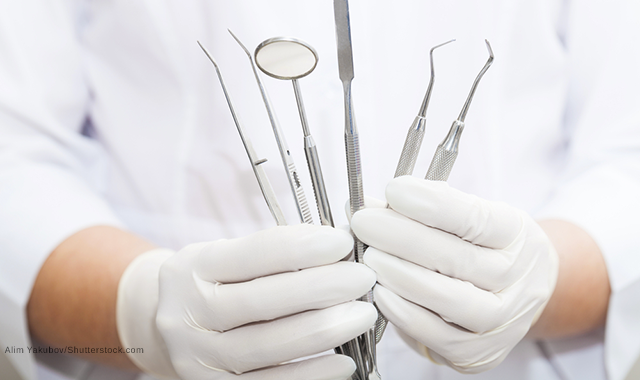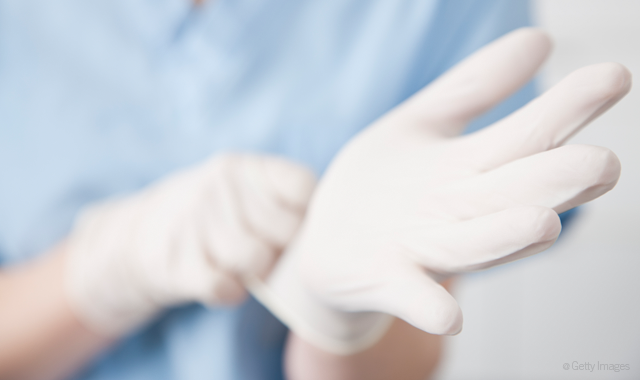5 things you need to know about personal protective equipment
Understanding when and why you need to wear PPE can help to prevent the spread of infection at your office.
Personal protective equipment (PPE) is meant to defend practitioners from accidental exposure to hazards and dangers. While its use seems straightforward enough (e.g., wear glasses to protect your eyes, wear gloves to protect your hands, etc.) there's more to it than that.

It’s critical for dentists and team members to understand what they need to wear, when they need to wear it and why they need to wear it. Having this knowledge will help to prevent the spread of disease within your office.
More from the author: Why good disease prevention is critical
Click through the slides to learn five things you need to know about PPE.


Safety net
At first blush, it may seem contrary to its purpose, but PPE isn’t meant to protect workers against known hazards. That is, everything that can be done should be done to ameliorate workers’ exposure to harm before they’re put in a risky situation. PPE is simply used as a safeguard.
Trending article: Using silver diamine fluoride as a new caries management solution
“OSHA requires an employer to use personal protective equipment as the last resort,” says Mary Borg-Bartlett, president of SafeLink Consulting. “In other words, the employer must try to eliminate the hazard first with feasible engineering and work practice controls. In the dental environment, engineering controls include suction, guards and shields. Work practice controls involve changing the way a task is performed to protect the worker. Examples could be using wet processes rather than dry that could create dust, and even rotating workers so that they don’t perform a job for long periods of time.”



Eyewear
It might be tempting to save a couple of dollars and buy lower cost equipment. However, as Joyce Moore, RDH, an infection control consultant and clinical instructor at Bristol Community College in Fall River, Massachusetts, observes, not all products are created equally. For instance, eyewear should meet specific standards; safety eyewear should have an ANSI code beginning with Z87 or Z87+ on the frame or lens.
“We want to be using the right eyewear because when we are using a dental handpiece, debris can be discharged at a rate of 50 miles per hour,” Moore explains. “Wearing polycarbonate safety glasses will protect us. After all, a jet windshield is made out of polycarbonate, so we should feel confident that it would protect us as well.”
Eyewear is not only important for staff but for patients, too. Moore tells the story of a patient who, in the midst of a root canal procedure, suffered a serious injury.
Related reading: The benefits of AdvantaClear Surface Disinfectant
“Not too long ago, a patient had a needle dropped in her eye and lost her eye,” Moore says. “Unfortunately, while the procedure was being done, it happened and they didn’t send her home; they just gave her a wet tissue to wipe her eye with. They didn’t take her to the eye wash; they just gave her a wet tissue and sent her home. She woke up hours later and she said it was the worst pain she’s ever had. She’s not the only one; she’s not the last one.”
Some practices might opt for a cheap pair of dollar store sunglasses to get the job done, but Moore says that the correct eyewear is necessary.
“It’s just very easy to pick something up at your local store,” Moore says. “It may not have the appropriate rating, but we also need to be thinking about, ‘Does it have side shields?’ Side shields help protect against debris from getting in the sides of the glasses. And the lenses have to be pretty large. If you do have a protective pair of eyewear, they shouldn’t have small lenses. They may be fashionable, but they may really not protect us. Often, dental suppliers will sell the appropriate eyewear and they are easy to order.”
Reusable equipment, like safety eyewear, must be stored appropriately, too.
“Because safety eyewear is reused, it should be placed in a container with the employee's name on the container when not being worn,” Borg-Bartlett says. “OSHA can cite for PPE being left on counters or in drawers where they can become contaminated. Also, PPE should not be shared, so the name identification helps with that issue.”



Sizing
Human beings wear different sized clothing because, obviously, fit differs from person to person. The same thought should extend to personal protective equipment.
“One size doesn’t necessarily fit all,” Borg-Bartlett says. “This means that an employer should provide multiple sizes when possible for items such as gloves, masks, gowns and safety eyewear.”
Even the most seemingly one-size-fits-all PPE is subject to variance affecting fit.
More from the author: The top 10 worst states to be a dentist
“Different styles of safety eyewear should also be available to workers,” Borg-Bartlett explains. “There is safety eyewear that go over prescription eyewear and are usually referred to as OTG, or over-the-glass. It’s very difficult in most cases to wear a regular size of safety eyewear over prescription eyewear. Also, there are different facial features such as the shape of the bridge of the nose that can present issues with fit. A worker with a flat bridge on the nose will find it difficult to comfortably wear eyewear that is not designed for that feature.”
Practices should revisit workers’ sizing periodically because things can change over time.
“Recently, I saw an XL glove in a dental practice, so even the size of hands is larger than years ago,” she adds.



The right tool for the job
In addition to physical sizing, one size doesn’t fit all when given tasks are performed.
“The personal protective equipment provided must protect the worker from the specific hazard,” Borg-Bartlett says. “An example would be determining the best glove for protection from corrosives. For instance, a neoprene glove rather than a latex glove. Another consideration would be protection from cuts when handling dirty instruments prior to sterilization. It’s best to use a heavier glove than a latex or nitrile glove to provide better protection. A vinyl glove would provide stronger protection in this case.
“The type of mask or respirator is also a concern,” she continues. “Once the hazard has been identified, then the employer can check the NIOSH rating. An example would be protection from most types of dust. An N95 respirator provides protection from most dusts created in the dental environment. If the hazard is a fume or vapor, then a different NIOSH-rated respirator could be required. Employers must be able to show OSHA how they determined the PPE that will protect their workers from recognized hazards.”
Trending research: Does periodontal disease cause eye problems?
“We know we have to use the right gloves, and if you’re using patient exam gloves for breaking down your operatory or working in the reprocessing area, you are putting yourself at risk for a sharps injury,” Moore observes. “This we know, but what you might not know is patient exam gloves are not necessarily designed to work with disinfectants and other chemicals we routinely use in the dental office. You should be using sharps- and chemical-resistant gloves that are required PPE. They look like kitchen gloves. Those keep us safe; those should be used. Exam gloves are not going to keep us safe against sharps and may not protect us against those chemicals that we are using.”
Regrettably, Moore frequently sees the wrong gloves being used.
“It happens all the time,” she says. “Those heavy or nitrile protective gloves, people often say they’re not well-fitting, they reduce my tactile sensitivity, but you’re not using them for dental procedures. You’re preparing instruments for reprocessing, and you shouldn’t need an exam glove to do that. That’s a shortcut that people take.”
The good news is that utility gloves can be reused a few times before having to be replaced.
“Typically, they can be sterilized, so they don’t necessarily need to be replaced,” Moore says. “But if you sterilize them more than about seven times, they’ll probably be ruined. So, for that reason, they can just be washed down. You can actually wear them and wash them down or you can clean them with a cleaner and then disinfect them and just let them dry.”



Masks
Face masks are also suited for specific jobs. Like so many other pieces of PPE, the right fit for the right job matters.
“We all know that wearing a properly fitting surgical mask protects us and the patient against the spread of disease, and we also know that masks are a single-use item and that we use one per patient, unless they get damp,” Moore says. “But what is often not understood is that there is a rating system for the masks we use. So, the mask you use is determined by the level of the task that you are undertaking. If you’ve got a high level of splatter or spray that’s going to be generated during a procedure, you want a higher-level mask. If we are doing less, where we have a low level of splatter, a Level 1 and then a moderate, a Level 2. But if they are using an ultrasonic scaler or an electric handpiece, that would be appropriate at a Level 3.”
Read more: How to conduct an infection control risk assessment in your office
Face masks are not especially expensive, and lately, Moore observes better compliance when it comes to changing masks.
“I think most hygienists are aware that you should be changing your mask one per patient,” Moore says. “But, as always, dentistry is an expensive field, between equipment and supplies, so I have seen that some offices will just change their masks every couple of patients, or maybe even less often. I think that’s something that’s been improving. More often than not, we’re seeing that, especially with students, we’re talking with them about how their mask should be rated because we’re generally buying those supplies for them and telling them why that’s our rationale.”
PPE is a ubiquitous part of the dental practice. However, while it’s widely worn, misconceptions about proper use and need can put practitioners and staff - as well as patients - at risk.
